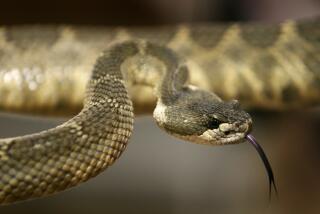Forget Tourniquets for Snakebite--Head to the ER
- Share via
When 3-year-old Matthew Peters was bitten above his left ankle by a rattlesnake last week in his Glendale back yard, his family wasted no time calling for help.
Within 45 minutes, the toddler was being treated in the emergency department at Childrens Hospital Los Angeles.
Matthew’s family serves as a textbook example of how to handle snakebite emergencies.
Forget all that cut, suck and tie-a-tourniquet stuff you may have heard about.
“The most important thing is to get to a hospital,” says Dr. Jerome Hoffman, professor of medicine and emergency medicine at UCLA Medical Center and a toxicology expert. “Keep the wound clean. Don’t make cuts. Don’t tie anything around the wound.”
The oft-prescribed tourniquet, meant to keep venom-filled blood from flowing back to the heart, is no longer considered effective first aid, Hoffman says, especially when performed by people without medical training. “It doesn’t work very well.”
If you must transport the victim yourself, keep the bitten extremity relatively immobile and at heart level or below, experts advise.
“Don’t pack the bitten area in ice,” says Lee Cantrell, a pharmacist and supervisor of the Los Angeles Regional Drug and Poison Information Center. But removing rings and watches is a good idea since swelling can occur.
Suctioning of venom from the wound is also discouraged because it must be done, Hoffman says, within a very narrow window or the technique can be harmful.
Time is better spent getting the victim to a hospital.
“No one’s going to get bitten and die immediately,” Cantrell says. Proceeding safely and sanely is the best bet, which is exactly what the Peters family did.
Matthew’s grandfather called 911 as soon as the family realized the toddler had been bitten by a rattlesnake. And his mother, Julie, a former lifeguard, says she “held him until the paramedics got there and I tried to calm him down.”
Once they arrived at the hospital, doctors took over.
“We ordered antivenin, gave a test dose and waited five minutes to see if there was any reaction,” says Dr. Calvin Lowe, the physician on duty when Matthew arrived by ambulance. Then the full dose was given.
The toddler underwent surgery Friday to debride the wound and was scheduled for a second debridement procedure on Monday. His condition has been upgraded to good, according to a hospital spokeswoman.
*
In the Los Angeles basin, the most common venomous snake is the Southern Pacific rattler, says Harvey Fischer, who has served for the past 25 years as curator of reptiles at the Los Angeles Zoo.
Southern Pacific rattlers have a diamond-like pattern on their backs. Young snakes are often greenish or goldish, while older ones can be black, gray or brown.
“There’s a lot of variation,” Fischer says. The average adult is 3 1/2 feet long, although some Southern Pacific rattlers can reach five feet.
In the high desert, sidewinder and Mojave rattlesnakes are seen, Fischer says, while sidewinders, red and speckled rattlesnakes are found in the Palm Springs area.
Of course, as Cantrell points out, snakes don’t always respect these boundaries.
Snakes are more likely to appear in new housing developments, Fischer says, in the desert and in foothill locations such as the Peterses’ home, which backs up to a mountain.
February to November is Southern California’s prime snakebite season. Still, rattlesnake bites are not a common occurrence, says Henry Gonzalez, former director of the Venom Lab at County/USC Medical Center and a university lecturer and consultant. In 1991, the latest year for which figures are available, 13 deaths in the United States were attributed to bites from snakes, lizards and spiders, according to the National Safety Council.
Children are more at risk of death because they are so small. Last year, the poison information center fielded calls for about 50 cases of rattlesnake bites in Southern California, Cantrell says.
The risk of bites can be reduced by taking simple precautions.
Build a very solid fence at least three feet tall, Fischer advises, ideally with no gate and no overhanging branches.
“Don’t leave lumber or firewood around,” he adds. These materials attract rodents, which in turn attract snakes.
“Don’t worry about killing the snake and bringing it in,” Hoffman says. But it can’t hurt to provide a description of the reptile.
Often snakebites are more the victim’s fault than the reptile’s. Many incidents, according to Fischer and Hoffman, involve adult victims who have had too much to drink and decide to take risks with snakes that they wouldn’t consider while sober.
Adult snakebite victims, research shows, tend to be male and have tattoos and therefore seem to be more likely to engage in risk-taking behavior, such as playing chicken with a snake.
(BEGIN TEXT OF INFOBOX / INFOGRAPHIC)
Safety Tips For a copy of a free rattlesnake bite prevention brochure, send a self-addressed stamped envelope to the Los Angeles Regional Drug and Poison Information Center, 1200 N. State St., Room 1102, Los Angeles, Calif. 90033.
More to Read
Sign up for Essential California
The most important California stories and recommendations in your inbox every morning.
You may occasionally receive promotional content from the Los Angeles Times.













